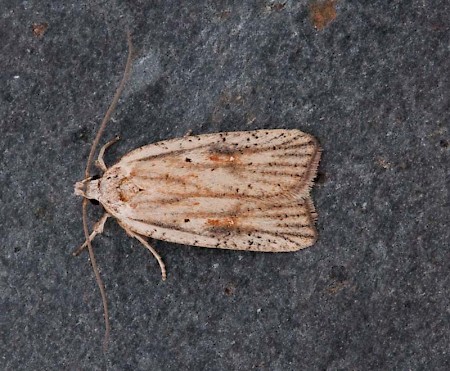32.03 BF706
Agonopterix nervosa
(Haworth, 1811)
Wingspan 16-22 mm.
One of the commonest Agonopterix species throughout Britain, readily coming to light from July to September. Some, at least, overwinter as adults and may appear at light in mid-winter.
The adults vary, but the forewing usually has a distinct whitish band curving from the base of the wing along nearly half of the costa. However, other species share this feature, so examination of the genitalia is suggested for specimens not reared from larvae on the correct foodplants. Fresh adults often have noticeably pink or purplish legs when viewed from certain angles.
The larva feeds in May and June from lightly spun shoots of broom (Cytisus scoparia), gorse (Ulex), Dyer's greenweed (Genista tinctoria), Petty whin (Genista anglica) and Tree lupin (Lupinus arboreus). It is the larval species most frequently found when beating the foodplants in season. Late instar larvae occur in several distinct colour forms; green, yellowish brown, brown and dark brown, which need care in distinguishing from larvae of several other species on the same foodplants (see more details below).
- Larva: (description Ian F. Smith):
Foodplant: In May and June from lightly spun shoots of Cytisus scoparia, Ulex, Genista tinctoria, Genista anglica and Lupinus arboreus.
Late instar
Length: All varieties described; 15 mm.
Head: Dark brown variably marked black, or all black. Mid-brown on some green larvae. Stemmatal area black.
Prothoracic shield: Light brown, divided by thin paler medial line. Often, but not always, heavily marked black laterally, or laterally and posteriorly, sometimes leaving only a small patch of brown at anterior.
Thoracic legs: Specimens with black markings on prothoracic shield usually have blackish legs. Specimens lacking black on prothoracic shield may have brown legs.
Body: Green form: Green or yellowish green. Dorsal line and wide dorsolateral line; darker green or grey green. Subspiracular area usually noticeably lighter than dorsolateral line above, and venter below.
Brown forms: Dorsally, and down to spiracles, some shade of dull brown. Sometimes paler subdorsal line interrupts brown into a dorsal line and dorsolateral line. Subspiracular area usually markedly pale, often yellowish.
Spiracles: Black.
Pinacula: Conspicuous, black. Usually ringed with paler integument.
Setae: Translucent, tinted brown
Anal plate: Pale brown or, on green larvae, green. May be heavily marked laterally with pitchy black.
Prolegs: Coloured as venter. Anal prolegs may have pitchy black lateral sclerite. Crochets dark brown.
Similar species (larvae)
Individual descriptions and illustrations of the species listed should be checked on this website for further details.
Dark brown and brown forms of A. nervosa (May-June), can usually be distinguished by their pale subspiracular flanks from:
702 A. assimilella (Oct-April, Cytisus)
705 A. umbellana (May-Aug, Ulex)
856 Anarsia spartiella (May-June, Cytisus and Ulex)
874 Blastobasis decolorella (most months, Ulex and many other plants)
Pale brown or yellowish forms should be compared with:
792 Mirificama mulinella (April-May, Cytisus and Ulex)
866 Brachmia blandella (June, Ulex)
Green forms should be compared with:
704 Agonopterix scopariella (June-July, Cytisus)
705 A. umbellana (May-Aug, Ulex)
792 Mirificama mulinella (April-May, Cytisus and Ulex)
998 Epiphyas postvittana (most months, Ulex and many other plants)

 UKMoths
UKMoths 











